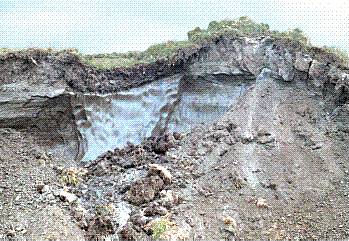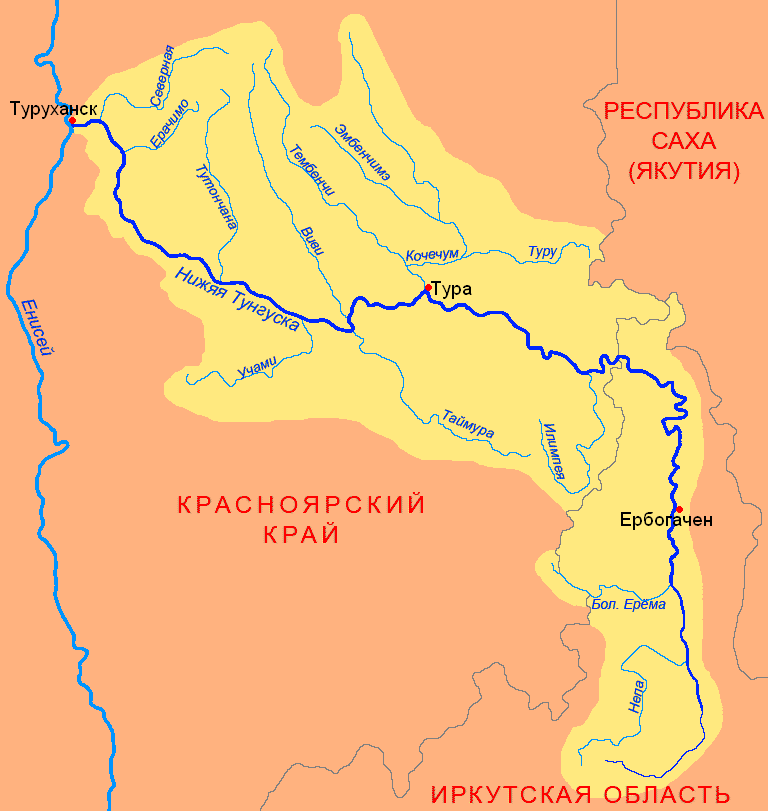|
Syverma Plateau
The Syverma Plateau ( rus, плато Сыверма) is a mountain plateau in Krasnoyarsk Krai, Siberia, Russia. It is a part of the Central Siberian Plateau. The plateau is located in largely uninhabited area. Geography The Syverma Plateau is located in central Krasnoyarsk Krai. To the north it merges with the Putorana Mountains and to the west the border with the Tunguska Plateau is not clearly defined. To the east the Syverma Plateau limits with the Vilyuy Plateau. Google Earth The average height of the plateau is between and . The Syverma Plateau is deeply cut by river valleys flowing roughly southwards from the Putorana ranges, such as the Vivi River, Tutonchana, Tembenchi, Embenchime, Kochechum and other right hand tributaries of the Lower Tunguska River. Geology Geologically the Syverma Plateau is made up of Triassic volcanic rocks. Flora and climate The plateau is covered by larch taiga. Owing to the permafrost trees grow very slowly.Enciclopedia Geografica ... [...More Info...] [...Related Items...] OR: [Wikipedia] [Google] [Baidu] |
Russia
Russia (, , ), or the Russian Federation, is a transcontinental country spanning Eastern Europe and Northern Asia. It is the largest country in the world, with its internationally recognised territory covering , and encompassing one-eighth of Earth's inhabitable landmass. Russia extends across eleven time zones and shares land boundaries with fourteen countries, more than any other country but China. It is the world's ninth-most populous country and Europe's most populous country, with a population of 146 million people. The country's capital and largest city is Moscow, the largest city entirely within Europe. Saint Petersburg is Russia's cultural centre and second-largest city. Other major urban areas include Novosibirsk, Yekaterinburg, Nizhny Novgorod, and Kazan. The East Slavs emerged as a recognisable group in Europe between the 3rd and 8th centuries CE. Kievan Rus' arose as a state in the 9th century, and in 988, it adopted Orthodox Christianity from the ... [...More Info...] [...Related Items...] OR: [Wikipedia] [Google] [Baidu] |
Google Earth
Google Earth is a computer program that renders a 3D representation of Earth based primarily on satellite imagery. The program maps the Earth by superimposing satellite images, aerial photography, and GIS data onto a 3D globe, allowing users to see cities and landscapes from various angles. Users can explore the globe by entering addresses and coordinates, or by using a keyboard or mouse. The program can also be downloaded on a smartphone or tablet, using a touch screen or stylus to navigate. Users may use the program to add their own data using Keyhole Markup Language and upload them through various sources, such as forums or blogs. Google Earth is able to show various kinds of images overlaid on the surface of the earth and is also a Web Map Service client. In 2019, Google has revealed that Google Earth now covers more than 97 percent of the world, and has captured 10 million miles of Street View imagery. In addition to Earth navigation, Google Earth provides a series ... [...More Info...] [...Related Items...] OR: [Wikipedia] [Google] [Baidu] |
Continental Climate
Continental climates often have a significant annual variation in temperature (warm summers and cold winters). They tend to occur in the middle latitudes (40 to 55 north), within large landmasses where prevailing winds blow overland bringing some precipitation, and temperatures are not moderated by oceans. Continental climates occur mostly in the Northern Hemisphere due to the large landmasses found there. Most of northern and northeastern China, eastern and southeastern Europe, Western and north western Iran, central and southeastern Canada, and the central and northeastern United States have this type of climate. Continentality is a measure of the degree to which a region experiences this type of climate. In continental climates, precipitation tends to be moderate in amount, concentrated mostly in the warmer months. Only a few areas—in the mountains of the Pacific Northwest of North America and in Iran, northern Iraq, adjacent Turkey, Afghanistan, Pakistan, and Central Asia ... [...More Info...] [...Related Items...] OR: [Wikipedia] [Google] [Baidu] |
Subarctic
The subarctic zone is a region in the Northern Hemisphere immediately south of the true Arctic, north of humid continental regions and covering much of Alaska, Canada, Iceland, the north of Scandinavia, Siberia, and the Cairngorms. Generally, subarctic regions fall between 50°N and 70°N latitude, depending on local climates. Precipitation is usually low, and vegetation is characteristic of the taiga. Daylight at these latitudes is quite extreme between summer and winter due to its high latitude. Near the summer solstice for instance, subarctic regions can experience an all-night period of either civil, nautical, or astronomical twilight (or in the northern reaches full daylight), but without true night, since the sun never dips more than 18 degrees below the horizon. Noctilucent clouds are best observed within this range of latitude. Climate and soils Subarctic temperatures are above for at least one and at most three months of the year. Precipitation tends to be ... [...More Info...] [...Related Items...] OR: [Wikipedia] [Google] [Baidu] |
Permafrost
Permafrost is ground that continuously remains below 0 °C (32 °F) for two or more years, located on land or under the ocean. Most common in the Northern Hemisphere, around 15% of the Northern Hemisphere or 11% of the global surface is underlain by permafrost, with the total area of around 18 million km2. This includes substantial areas of Alaska, Greenland, Canada and Siberia. It can also be located on mountaintops in the Southern Hemisphere and beneath ice-free areas in the Antarctic. Permafrost does not have to be the first layer that is on the ground. It can be from an inch to several miles deep under the Earth's surface. It frequently occurs in ground ice, but it can also be present in non-porous bedrock. Permafrost is formed from ice holding various types of soil, sand, and rock in combination. Permafrost contains large amounts of biomass and decomposed biomass that has been stored as methane and carbon dioxide, making tundra soil a carbon sink. As global ... [...More Info...] [...Related Items...] OR: [Wikipedia] [Google] [Baidu] |
Taiga
Taiga (; rus, тайга́, p=tɐjˈɡa; relates to Mongolic and Turkic languages), generally referred to in North America as a boreal forest or snow forest, is a biome characterized by coniferous forests consisting mostly of pines, spruces, and larches. The taiga or boreal forest has been called the world's largest land biome. In North America, it covers most of inland Canada, Alaska, and parts of the northern contiguous United States. In Eurasia, it covers most of Sweden, Finland, much of Russia from Karelia in the west to the Pacific Ocean (including much of Siberia), much of Norway and Estonia, some of the Scottish Highlands, some lowland/coastal areas of Iceland, and areas of northern Kazakhstan, northern Mongolia, and northern Japan (on the island of Hokkaidō). The main tree species, depending on the length of the growing season and summer temperatures, vary across the world. The taiga of North America is mostly spruce, Scandinavian and Finnish taiga consists ... [...More Info...] [...Related Items...] OR: [Wikipedia] [Google] [Baidu] |
Larch
Larches are deciduous conifers in the genus ''Larix'', of the family Pinaceae (subfamily Laricoideae). Growing from tall, they are native to much of the cooler temperate northern hemisphere, on lowlands in the north and high on mountains further south. Larches are among the dominant plants in the boreal forests of Siberia and Canada. Although they are conifers, larches are deciduous trees that lose their needles in the autumn. Etymology The English name Larch ultimately derives from the Latin "larigna," named after the ancient settlement of Larignum. The story of its naming was preserved by Vitruvius: It is worth while to know how this wood was discovered. The divine Caesar, being with his army in the neighbourhood of the Alps, and having ordered the towns to furnish supplies, the inhabitants of a fortified stronghold there, called Larignum, trusting in the natural strength of their defences, refused to obey his command. So the general ordered his forces to the assault. In ... [...More Info...] [...Related Items...] OR: [Wikipedia] [Google] [Baidu] |
Volcanic Rock
Volcanic rock (often shortened to volcanics in scientific contexts) is a rock formed from lava erupted from a volcano. In other words, it differs from other igneous rock by being of volcanic origin. Like all rock types, the concept of volcanic rock is artificial, and in nature volcanic rocks grade into hypabyssal and metamorphic rocks and constitute an important element of some sediments and sedimentary rocks. For these reasons, in geology, volcanics and shallow hypabyssal rocks are not always treated as distinct. In the context of Precambrian shield geology, the term "volcanic" is often applied to what are strictly metavolcanic rocks. Volcanic rocks and sediment that form from magma erupted into the air are called "volcaniclastics," and these are technically sedimentary rocks. Volcanic rocks are among the most common rock types on Earth's surface, particularly in the oceans. On land, they are very common at plate boundaries and in flood basalt provinces. It has been est ... [...More Info...] [...Related Items...] OR: [Wikipedia] [Google] [Baidu] |
Lower Tunguska River
The Nizhnyaya Tunguska ( rus, Ни́жняя Тунгу́ска, p=ˈnʲiʐnʲɪjə tʊnˈɡuskə, meaning "Lower Tunguska") is a river in Siberia, Russia, that flows through the Irkutsk Oblast and the Krasnoyarsk Krai. The river is a right tributary of the Yenisey joining it at Turukhansk (see Siberian River Routes). Settlements on the river include Tura, Yukti and Simenga. The ice-free period on the ''Nizhnyaya Tunguska'' starts in mid-June and ends in the first half of October. The river forms the western limit of the Lena Plateau. Hydrography The Nizhnyaya Tunguska is the second largest right tributary of the Yenisey, and joins it near the town of Turukhansk. It is long, and has a drainage basin of . According to the character of the stream, constitution of the river's valley and its shores, it can be divided into two parts: the first one starts at the source of the river and continues down to the village Preobrazhenskoye and the second section of the river lies downstream ... [...More Info...] [...Related Items...] OR: [Wikipedia] [Google] [Baidu] |
Kochechum River
The Kochechum (russian: Кочечум) is a river in Siberia, Russia, it flows through the Syverma Plateau in Krasnoyarsk Krai. It is a right and most significant tributary of the Nizhnyaya Tunguska. General information The river is long, and its watershed covers . The average discharge at the mouth is .Плато Путорана ''Студенческий туристский клуб «Фортис»'' The part of its basin near the source lies on the southern slopes of . It flows to the south direction through and joins [...More Info...] [...Related Items...] OR: [Wikipedia] [Google] [Baidu] |
Tembenchi River
The Tembenchi (russian: Тембенчи) is a major river of Krasnoyarsk Krai in Siberia, central Russia, joining the Kochechum to the northwest of Tura. The river, which has its source in the Putorana Plateau, is long, and its basin covers . The river runs through the remote, sparsely inhabited Syverma Plateau with a very severe climate; there is no vegetation, except mosses, lichens and herbs. Like all Siberian rivers, it suffers from long periods of frost for six to seven months a year, from late October to May, and large tracts of land remain permanently frozen at depth. The river is fed mainly by snowmelt and its high water lasts from late May through until September. Its lower course is characterised by basalts, draining a narrow and rather deep valley of the northwest of the Central Siberian plateau known as Syverma Plateau The Syverma Plateau ( rus, плато Сыверма) is a mountain plateau in Krasnoyarsk Krai, Siberia, Russia. It is a part of the Central Siberi ... [...More Info...] [...Related Items...] OR: [Wikipedia] [Google] [Baidu] |




